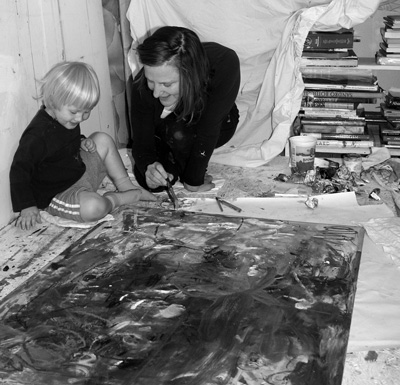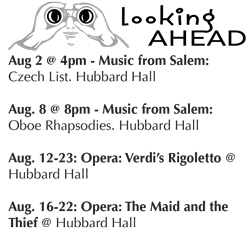News & Issues July 2015
A toddler as muse
Bennington artist blends family, creative lives in works that challenge
By TELLY HALKIAS
Contributing writer
BENNINGTON, Vt.
The artist Renee Bouchard has lately been inviting her 2-year-old son, Ensor, to share in her creative process. The result is a series of paintings that will be on display at two locations in downtown Bennington this summer and fall. Courtesy photo/Jamie Franklin
For Renee Bouchard, the path to visual art began in melodies and harmonies
When she was growing up in Mont Vernon, N.H., she covered her music lesson books with colorings. Her parents sensed a future painter in their midst and set her on the path she has stayed on to this day.
“So they sent me instead to art lessons with local artists,” Bouchard said with a laugh from her Bennington studio, fondly recalling her beginnings in the craft. “I remember referencing postcards of snowy scenes and learning to paint pastel portraits from life.”
Today she is becoming recognized as one of the emerging young artists of southwestern Vermont. She lives in Bennington with her husband, Jamie Franklin, who is curator of the Bennington Museum, and their 2-year-old son Ensor.
Her new exhibition, “Painting Interrupted” the latest of several shows in the past few years, opens July 25 at the Bennington Free Library and runs through November. Selected works of hers are also in display through the summer at Cake Gallery, at the intersection of Main and South streets in downtown Bennington.
“Painting Interrupted” explores the scribbling stage of children’s art while balancing Bouchard’s artistic practice with her personal experience raising a toddler. She said the multi-media paintings are collaborations in which Ensor and other children have been invited to join the creative process.
“You can expect to see experimental collaborative paintings with children using old and discarded materials, made without using brushes or traditional palettes,” Bouchard said. “The inspirations were artists like Joan Snyder, Paul Klee, Charlie Lucas, and hooked rugs by artists from the 19th century.”
Bouchard explained that one goal of her recent work is to preserve an unspoiled dialogue between her son documenting “an intuitive wisdom and connection to subtle and minor manipulations of material.”
In this work, she said she considers herself simultaneously playing the role of shaman, mother goddess and a child seeing the world with fresh eyes. She said the work evokes “the spirit of prehistoric cave paintings, a time when visual communication came before words.”
Wendy McDaris, owner of the McDaris Fine Art Gallery in Hudson, N.Y., hosted Bouchard’s show “Confluence” in 2013. McDaris, a longtime admirer of Bouchard’s art, said the artist’s paintings are original works that give viewers the opportunity to contribute philosophically and psychologically -- or in any way they see fit.
“Renee is an extraordinarily gifted artist and has been from a young age,” McDaris said. “Her paintings are filled with mystery that allows viewers to partially own the ideas in the works themselves. She is consciously or unconsciously aware that works of art seek a dialogue, and she accomplishes that feat most decidedly through palette and a brand of abstraction all her own.”
Creative education
Bouchard agreed that her early years shaped her creative development. Small-town life led her to further this early evolution by way of progressive education.
After her childhood in Mont Vernon, she attended high school at one of the Coalition of Essential Schools, a growing nationwide network that describes itself as “schools, centers, organizations and individuals working together to create and sustain personalized, equitable and intellectually challenging schools.”
There, Bouchard made a defining statement of where her future was headed. She said everyone from family to community pitched in in a collaborative effort that helped express her unique vision as she prepared to head to college – first at the Cleveland Institute of Art, and then to the Maine College of Art, from which she earned a bachelor of fine arts.
To graduate from Maine College of Art, Bouchard had to complete a senior project that she described as “a yearlong essential question.”
“I chose to make a steel mobile inspired by Alexander Calder, with the help of my father, who owns a steel erecting company,” Bouchard recalled. “The telephone company installed it for me outside the building and donated the pole.”
Even so, Bouchard said the greatest artistic experience of her formative years came when she was 16 and spent a summer at the Phoebe Flory Watercolor School in her hometown of Mont Vernon. Flory, a well-known painter and teacher, was co-author of the instructional book “Watercolor Portraiture: A Practical Guide,” published in 1985 and still in print; she died in 2014 at age 90.
Bouchard was so determined to study with Flory that she paid for the course by helping Flory in her garden and studio. She recalled that Flory’s school, to which she could ride daily on her bike, was rigorous yet maintained a bohemian flair.
“My parents didn’t approve of me going with the class during lunch breaks to a privately owned quarry to swim in the nude, so I had to ride my bike home for lunch too,” Bouchard said.
She said Flory and Eliot O’Hara published the book, “Portraits in the Making,” and designed an intensive program in which students learned to draw and paint portraits in watercolor using planes as the basic building block. Students in Flory’s school painted more than 200 portraits in watercolor, from talking or moving models, over the course of six weeks.
“I learned a ton of techniques from Phoebe that I still use today,” Bouchard said.
Family life as art
Bouchard’s home life has stood out in most of her recent work as both her grounding and her inspiration. She moved to Bennington in 2004 and married Franklin in 2010, and she said her family life is intertwined with her work, as both she and Franklin collect art too.
Franklin said that having two people so immersed in the arts and then joining as a couple makes for cross-gender dynamics and educational aspects to their relationship that benefits both their work.
“As an art historian, I can honestly say I didn’t really fully understand the artistic process until I met Renee,” Franklin said as he surveyed one of his galleries at the Bennington Museum. “As a result of being in a daily relationship with an artist who works as Renee does, I’ve developed a deeply felt sense that the best art is one in which the gap between the artist’s lived experience and their work is the most seamless. Seeing Renee’s work develop on an almost daily basis has been incredibly eye opening.”
Franklin said viewers often approach works of art -- especially those in a museum or gallery, but also images in books and online -- as finished, static objects with a finite meaning.
But he said his wife has demonstrated a more dynamic side to creating finished products.
“Watching Renee work in the studio, and seeing her process from start to finish -- inspiration to exhibition, brushstroke to brushstroke, painting to painting, and from year to year -- has been an incredibly valuable and rewarding experience for me,” he said.
Franklin added that watching Bouchard work has reminded him that appreciating art “is as much about the means as it is the end.”
“I know there’s a ton of work involved, but Renee seems able to transition effortlessly from artist to mother to life partner and integrate all those different facets of her life directly into her work,” he said.
Her ability to combine family life and her art has become even more striking since their son Ensor was born, Franklin said.
Within months of his birth, Ensor was in the studio with Bouchard on a regular basis, inspiring a series of works, “Baby Ensor: Recent Paintings,” that were shown at Southern Vermont College’s Burgdorff Gallery in the fall of 2013.
By the time Ensor was 9 months old, Bouchard began actively engaging him in her artistic process and using his developing visual communication skills as an integral aspect of her work, a process that continues to this day.
Longtime Vermont art critic Arlene Distler, who visited Bouchard’s Bennington studio in 2012 when Ensor was less than a year old, agreed this family dynamic has played a major role in her work.
“I’d come to know Bouchard as a painter of luminous abstract oils, their dense surfaces often inspired by nature,” Distler said from her Brattleboro home. “However, instead of the oil paintings, Bouchard’s studio was strewn with big pieces of thick Arches watercolor paper. Unmistakable images of Ensor stared out from them in purples, oranges and blues. She embraced the idea of her baby as muse.”
Franklin agreed that having Ensor as an inspiration results in work that is very personal, and he said there’s always a danger that Bouchard’s work could become too cryptic as a result. But he explained that as in poetry, the hope is that the personal aspect of the work is “transmuted into a universal when experienced by someone out in the world.”
At home in Vermont
Bouchard has been an elementary school art teacher, an inhabitant of Peak’s Island off the coast of Maine, and a traveler to both Europe and Morocco. But she is happy now to call southern Vermont home and said she is best suited to the rhythms of the seasons here.
“I’m at home in New England, and I love the four seasons because I love experiencing the cycle of life,” Bouchard said. “I love living in Vermont and being around people who are interested in sustaining our environment and ourselves.
“Now I’m completely preoccupied with my woodland garden and am working on a mosaic bird bath using historic shards of Vermont pottery and ceramic mugs created by local potters including Josh Primmer and Mark Shapiro.”
Having also moved between painting, sculpture and other media, Bouchard said that although her family life is a solid foundation, her art will always be changing.
“My mediums and styles are constantly changing, because my process always includes rule breaking and experimentation due to the fact that I am constantly questioning freedom,” she said. “My family life perpetuates my challenges, questions and limitations in my art-making practice.
“I don’t earn a paycheck as a stay at home mother-artist,” she added. “Our ethics coincide with our incomes, and we’re a one-car family, without a driveway, and yet so lucky to have such wonderful works of art at home with which we get to live.”
For more information about Renee Bouchard’s art, visit www.renee-bouchard.com.


